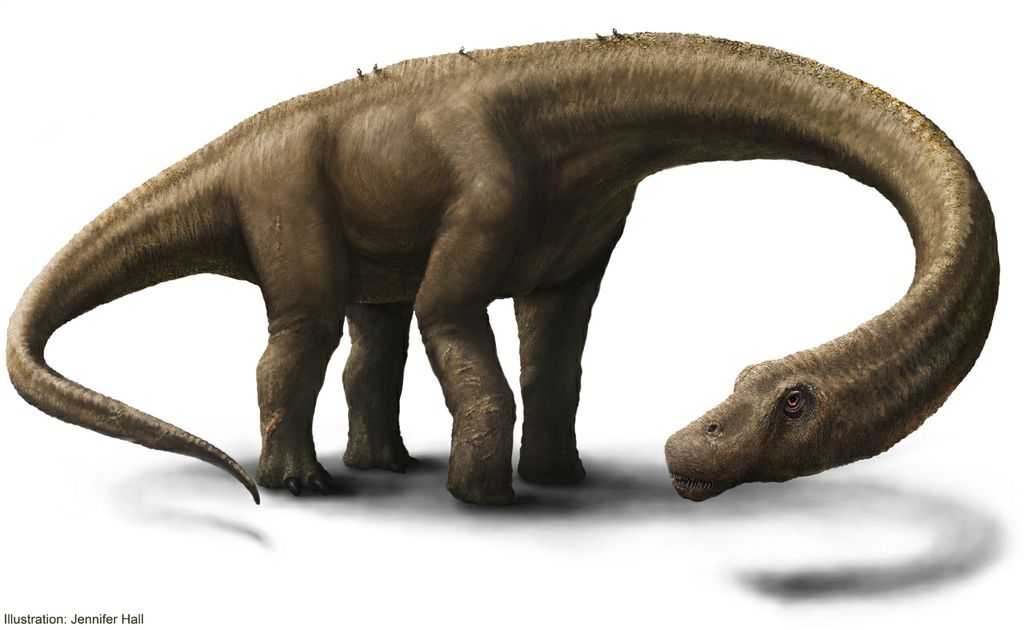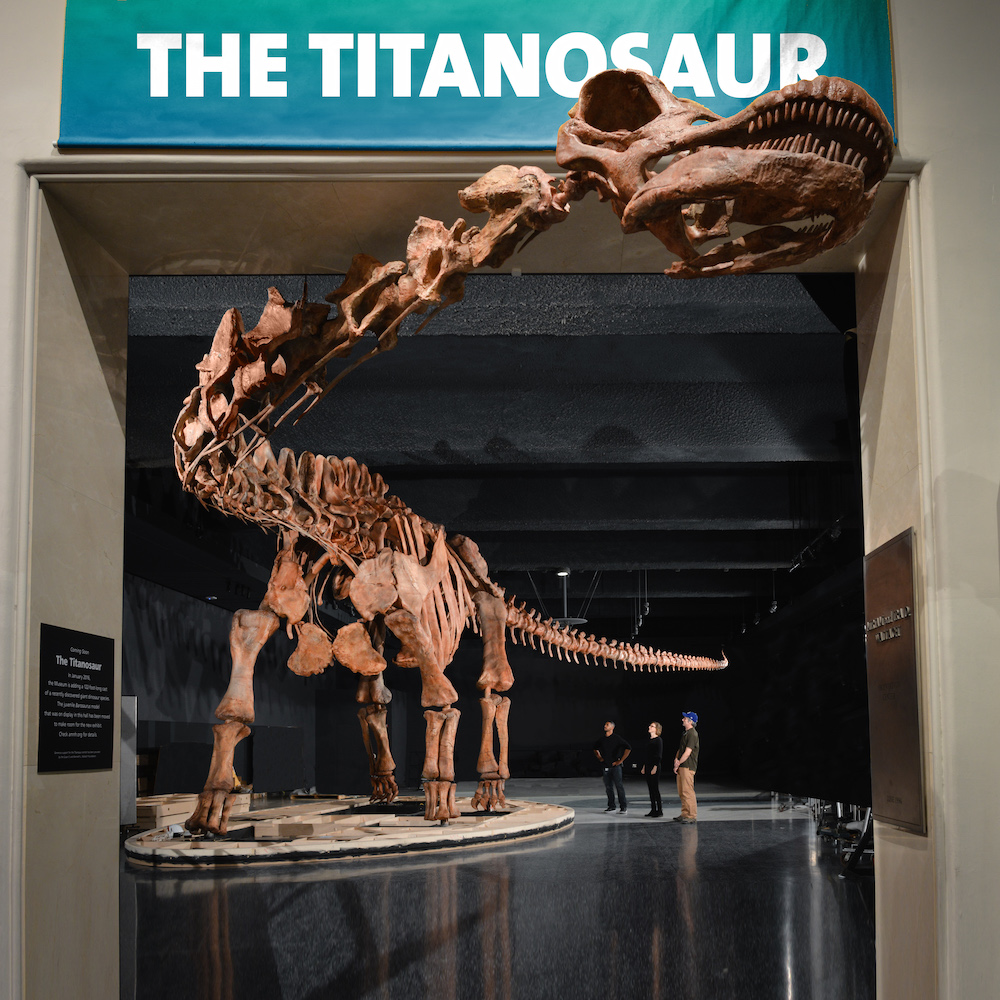What's the world's largest dinosaur?

Will we ever know for sure?
The battle for the title of world's largest dinosaur is complicated.
Here's why: Paleontologists rarely discover an entire skeleton. They're more likely to uncover bone fragments and then try to estimate a profile of height and weight. Moreover, there are three categories for largest dinosaur on record: the weightiest, longest and tallest.
Starting with the weightiest, the gold-medal winner is likely Argentinosaurus. This supermassive titanosaur (a titanosaur is a giant sauropod, a long-necked and long-tailed herbivorous dinosaur) that lived about 100 million to 93 million years ago, during the Cretaceous period, in what is now (you guessed it) Argentina.
Related: What happened when the dinosaur-killing asteroid slammed into Earth?
But estimates of Argentinosaurus' weight vary widely; the beast weighed 77 tons (70 metric tons), according to London's Natural History Museum; up to 90 tons (82 metric tons), according to New York City's American Museum of Natural History; and 110 tons (100 metric tons), according to BBC Earth.
It's no wonder these calculations are all over the place. Argentinosaurus is known from just 13 bones: six midback vertebrae, five fragmentary hip vertebrae, one tibia (a shinbone) and one rib fragment. "There's a femur that you'll see with it [in some sketches], but that femur was found 15 kilometers [9 miles] away. So, who knows who that belongs to?" Kenneth Lacovara, a professor of paleontology and geology and the dean of the School of Earth & Environment at Rowan University in Glassboro, New Jersey, told Live Science.
Another contender is Patagotitan, a titanosaur that weighed a whopping 69 tons (62 metric tons) when it lived about 100 million years ago in what is now Argentina. However, this weight was calculated based on a composite of individuals (there were six found in all), rather than just one dinosaur, Lacovara noted.
Get the world’s most fascinating discoveries delivered straight to your inbox.
Which raises the question: How do scientists calculate the weight of an extinct animal? According to Lacovara, there are three ways.
Minimum shaft circumference method: Scientists measure the minimum circumference of the humerus (the upper arm bone) and femur (the thigh bone) from the same individual. Then, they plug these numbers in to a formula. The result is highly correlative with the animal's mass. "It makes sense," Lacovara said, "since all quadrupeds have to put all of the weight of the body on just those four bones. [So], the structural properties of those four bones are going to correlate closely with the mass."
There are caveats, however. If the humerus and femur bone are from different individuals, as they were with Patagotitan, "the result is an estimate of a composite individual that never actually existed," Lacovara said. Moreover, if only a single bone (a humerus or a femur) is used, the proportions of the missing bone are a guess. "Obviously, this introduces even more uncertainty," he said. "Examples of this are Notocolossus and Paralititan."
The largest known dinosaur that has a humerus and femur bone from the same individual is the 77-million-year-old Dreadnoughtus, a 65-ton (59 metric tons) titanosaur that Lacovara and his team excavated in Argentina.
Volumetric method: In this approach, researchers determine the body volume of the dinosaur and use that number to calculate the animal's weight. This is challenging, because most titanosaur skeletons are incomplete. (Dreadnoughtus is the most complete, at 70%. Argentinosaurus is just 3.5% complete.) In addition, researchers have to guess how much space the lungs and other air-filled structures took up. Experts also have to speculate how "blubbery or shrink-wrapped" the skin on these dinosaurs was.
"In my view, this method is unworkable and lacks replicability, which is one of the hallmarks of science," Lacovara said.
Wild guesses: This is how scientists estimate the weight of dinosaurs that don't have any preserved humerus or femur bones. "Argentinosaurus, Futalognkosaurus and Puertasaurus are examples of this," Lacovara said. "They are clearly huge, but there is no systematic, replicable way to estimate their mass."
Moving on, what's the longest dinosaur? The whipped-tailed Supersaurus, a sauropod that lived about 150 million years ago during the Jurassic period, is a clear winner, reaching at least 128 feet (39 m) long, unpublished research finds. Another extraordinarily long dinosaur is Diplodocus, a slender and elongated sauropod that reached about 108 feet (33 m) long, according to a 2006 study of a specimen known as Seismosaurus in the New Mexico Museum of Natural History and Science Bulletin.
Realted: How Did Dinosaurs Grow So Huge?
In contrast, the titanosaurs were shorter. For example, Dreadnoughtus was "only" about 85 feet (26 m) long.
But this category is still rife with uncertainty. "Some dinosaurs claimed to be the longest are extremely fragmentary," Lacovara said. "For example, Sauroposeidon is known from just four neck vertebrae. So, really, who knows?" Meanwhile, Amphicoelias, a sauropod known from only a sketch of a single vertebra in a notebook from the 19th century paleontologist Edward Cope, is sometimes cited as the longest, tallest and heaviest dinosaur.
"The vertebra was apparently lost or destroyed in transport — or maybe never existed," Lacovara said. "You can't have a dinosaur represented by nothing, so as far as I'm concerned, Amphicoelias is not a thing."
As for the tallest dinosaur, the winner is likely Giraffatitan, a 40-foot-tall (12 m) sauropod dinosaur that lived in the late Jurassic about 150 million years ago in what is now Tanzania.
As for that dinosaur's actual height, the devil is in the details.
"This, of course, depends on whether these animals could lift their necks up to maximum height," Lacovara said. "Their forelimb and shoulder structure looks like they were angling their necks upward, but we may never know the degree to which they could do this."
Editor's Note: This article was originally published on Oct. 10, 2012, and was updated on Jan. 27, 2019. It was updated again on Nov. 15, 2021 to include information about Supersaurus.
Originally published on Live Science.

Laura is the managing editor at Live Science. She also runs the archaeology section and the Life's Little Mysteries series. Her work has appeared in The New York Times, Scholastic, Popular Science and Spectrum, a site on autism research. She has won multiple awards from the Society of Professional Journalists and the Washington Newspaper Publishers Association for her reporting at a weekly newspaper near Seattle. Laura holds a bachelor's degree in English literature and psychology from Washington University in St. Louis and a master's degree in science writing from NYU.




